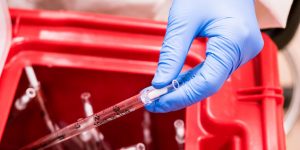Is Medical Waste Pollution a Problem in the U.S.?
Is treatment of medical waste pollution a problem in the U.S.?
The need for proper medical waste removal was realized when, in the 1980s, beaches were being littered with disposed syringes, medications, and other healthcare-related waste. While medical waste disposal is primarily regulated at the state level, federal laws have dictated the safety and efficacy of how each state implements waste removal, disposal, and treatment to prevent pollution and the spread of infection.
Laws such as Resource Conservation and Recovery Act (RCRA, pronounced “rick-rah”) are implemented by EPA and are in place to protect the environment, conserve resources, and reduce the amount of waste being generated. RCRA gave us the first regulations for the management of hazardous waste. This included the identification of solid and hazardous wastes, standards for generators of hazardous waste, standards for transporters of hazardous waste, and standards for hazardous waste disposal facilities.
In terms of pollution beyond improper disposal, we need to look at how medical waste is treated. Before 1997, over 90 percent of potentially infectious medical waste was incinerated. According to the Healthcare Environmental Resource Center, medical incinerators were found to be significant sources of airborne mercury. It was in 1994 that the EPA’s Draft Dioxin Reassessment identified medical waste incineration as the single largest source of dioxin air pollution. Since then, the EPA created stringent emission standards for medical waste incinerators due to significant concerns over poor air quality.
While incineration is highly effective as a method to treat medical waste, and while it is still an acceptable treatment alternative in many states, the question remains about pollution and air quality.
According to Greenpeace, 85 percent of the total medical waste stream in hospitals consists of the same mixture of discarded paper, plastic, glass, metal and food waste that is found in ordinary household waste. The remaining 15 percent is defined as infectious, which must be sterilized and treated before final disposal.
An estimated 45 percent of infectious medical equipment from Western hospitals is already reused through autoclaving. Autoclaving is a process that steam sterilizes infectious waste, and it allows for the reuse or recycling of medical equipment.
Exactly how much pollution occurs in the U.S. is unknown, but minimizing what is incinerated is the goal for healthcare facilities. Medical waste generators can reduce the quantity of PVC plastics, products, and packaging that are going to incineration. Plastics should also be recycled to the maximum extent possible. Aside from autoclaving, other treatment alternatives include hydropulping, microwave, chemical treatment, and irradiation.
Red Bags is committed to preserving the environment through our safe and effective medical waste disposal solutions. 90 percent of our medical waste is autoclaved, and we can provide the necessary equipment for proper segregation, labeling, and discarding, which is integral to safe disposal.
Contact us today to learn more about how you can reduce medical waste in your facility and do your part to reduce medical waste pollution.
Read more about Red Bags’ Medical Waste Removal Services & Related Topics:
- What Happens to Medical Waste Eventually?
- Improper Medical Waste Packaging: What You Need To Know
- What Happens to Medical Waste When It Leaves Your Facility?
- Better Medical Waste Management Resolutions

Service Areas: Long Island Medical Waste; New York City Medical Waste; Westchester Medical Waste and more!
